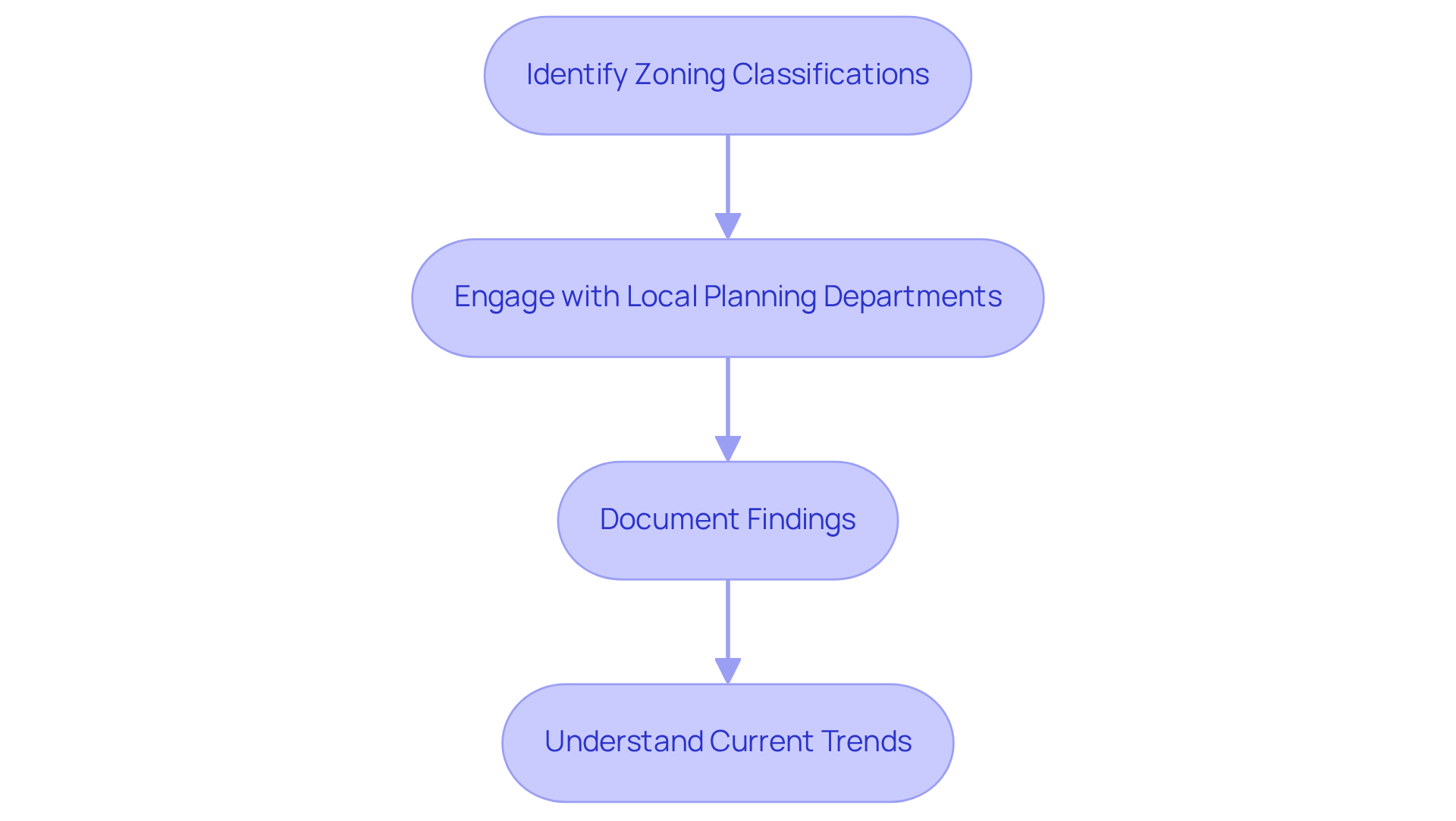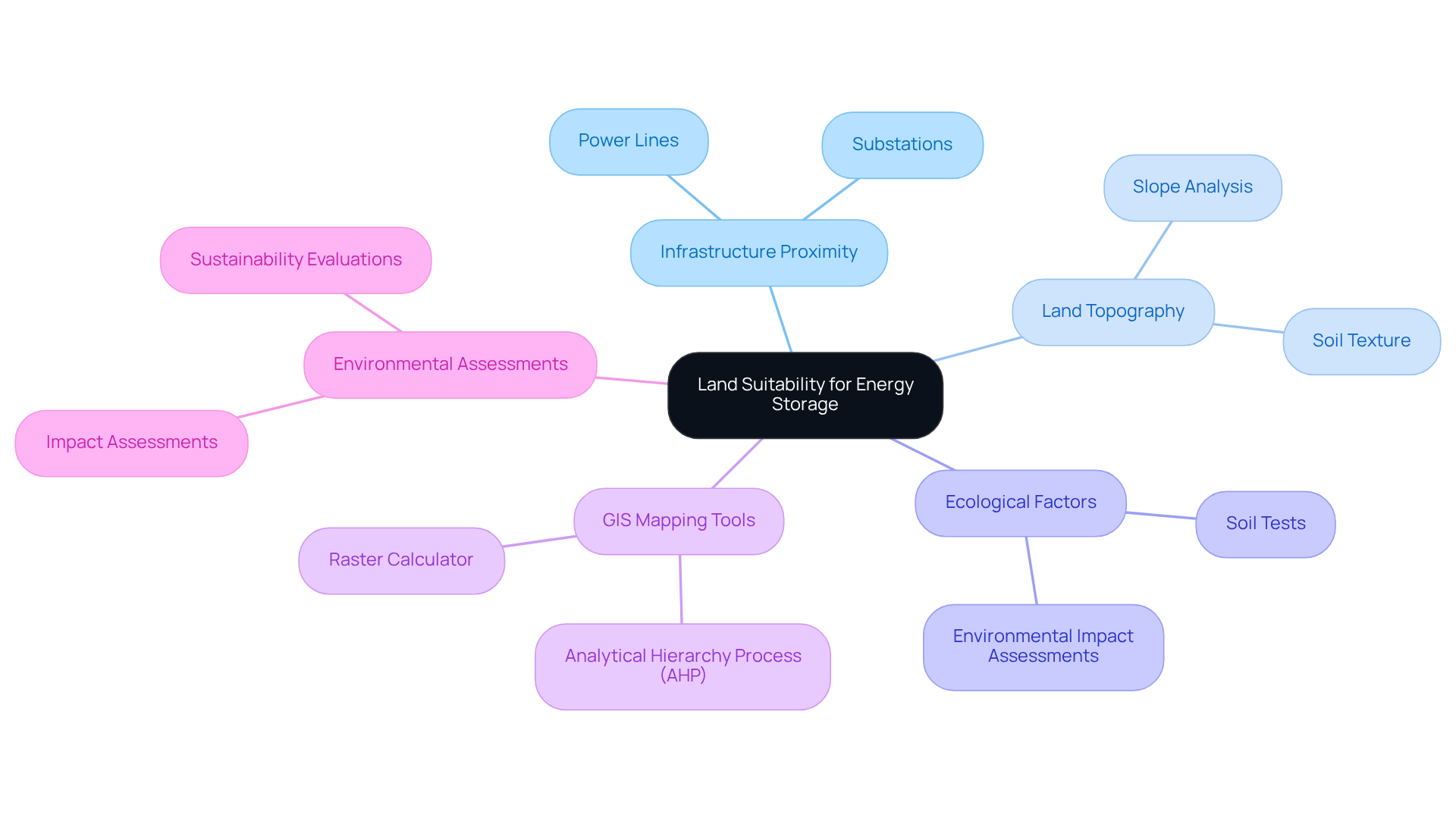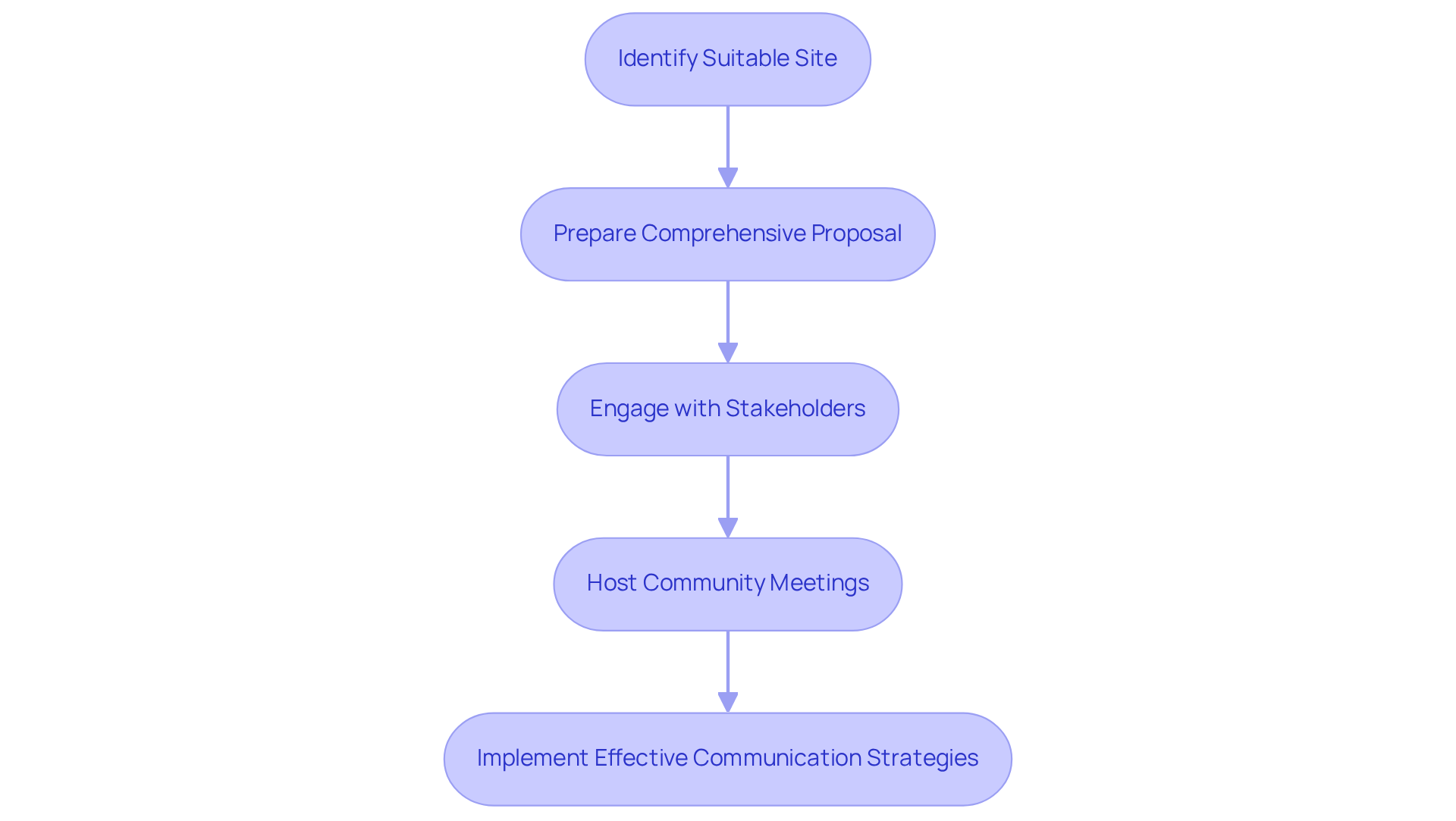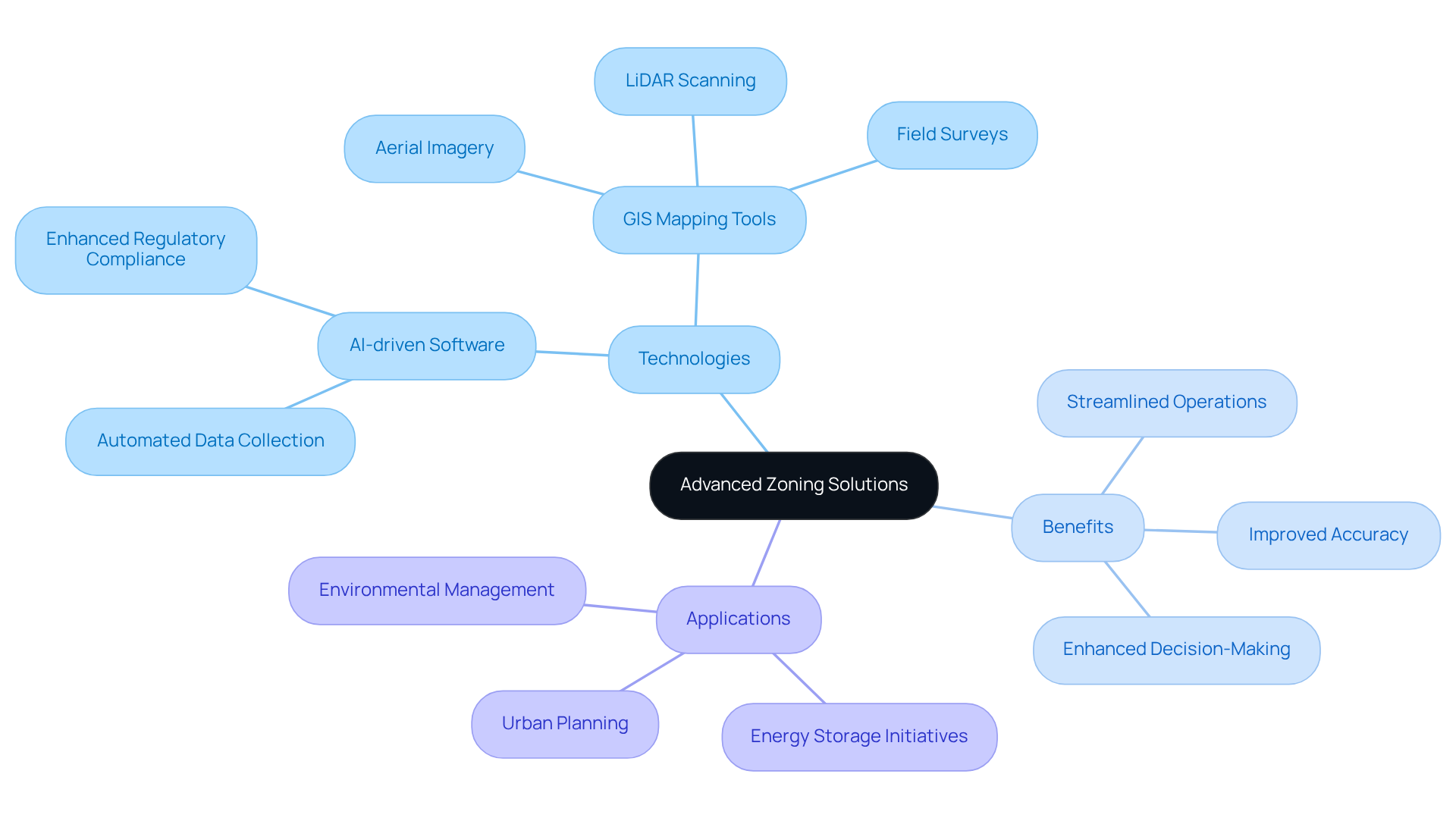Overview
The article delineates four critical steps necessary for the implementation of advanced zoning solutions in energy storage. These steps encompass:
- Understanding zoning regulations
- Assessing land suitability
- Negotiating with stakeholders
- Leveraging technology
Each step is meticulously supported by practical guidance and illustrative examples, such as the pivotal role of GIS mapping in land evaluation and the essential nature of community engagement in garnering support for energy initiatives. This highlights the comprehensive approach required for successful implementation, addressing the complexities of land acquisition and the legal and regulatory challenges involved.
Introduction
Navigating the complex landscape of energy storage implementation presents significant challenges, particularly in understanding zoning regulations and land-use policies. As energy demands escalate, the integration of advanced zoning solutions becomes crucial for optimizing land for power retention.
How can stakeholders effectively align their initiatives with local regulations while addressing community concerns? This guide delves into the essential steps required to implement sophisticated zoning strategies that not only comply with regulations but also cultivate community support.
By leveraging technology, stakeholders can enhance decision-making processes, ensuring a harmonious balance between regulatory compliance and community engagement.
Understand Zoning Regulations for Energy Storage
To effectively implement sophisticated land-use strategies for power retention, a thorough examination of local land-use policies is imperative. Start by identifying the specific zoning classifications that apply to energy storage systems, which may include advanced zoning solutions for energy storage such as utility uses or essential services.
For example, the Battery Energy Storage System Model Law outlines a framework for the siting of these systems, detailing the necessary requirements. Engaging with local planning departments is essential to clarify any uncertainties and ensure that your initiative aligns with community standards and expectations.
Documenting your findings will create a valuable reference manual, aiding future actions and ensuring compliance with local regulations. Notably, as of 2023, 59 jurisdictions have enacted ordinances addressing battery power systems, indicating a significant trend in regulatory oversight. Understanding these classifications and regulations is crucial for the successful implementation of advanced zoning solutions for energy storage.

Assess Land Suitability for Energy Storage Projects
To effectively evaluate land appropriateness for power-related initiatives, it is crucial to begin with a thorough analysis that examines key elements such as proximity to existing infrastructure—specifically power lines and substations—along with land topography and ecological factors. A study indicates that nearly 80% of Gaziantep's land is suitable for PV farm installation, underscoring the critical role of location in power projects.
Utilizing GIS mapping tools, such as the Analytical Hierarchy Process (AHP), allows for the visualization of potential locations, facilitating a comprehensive evaluation of their compatibility with advanced zoning solutions for energy storage. Furthermore, conducting soil tests and environmental impact assessments is advisable to identify any challenges that may arise during installation or operation.
As noted by Semih Sami Akay, "The study concludes that GIS-based AHP is an effective tool for rapid and reliable decision-making in renewable resource site selection." This information should be compiled into a detailed report that highlights the strengths and weaknesses of each location, thereby supporting informed decision-making for optimal outcomes.

Negotiate with Stakeholders for Land Acquisition
Upon identifying a suitable site, it is imperative to initiate negotiations with landowners and relevant stakeholders. Begin by preparing a comprehensive proposal that clearly outlines the advantages of the energy storage initiative. This proposal must address potential concerns, emphasizing transparency and trust. Engage in open conversations regarding compensation, land use agreements, and necessary modifications to regulatory frameworks.
Hosting community meetings is essential; these gatherings not only provide a platform for feedback but also help reduce opposition by fostering a sense of inclusion and support for the initiative. Effective communication strategies are vital for building strong relationships with stakeholders, ensuring that their perspectives are valued and considered throughout the process.

Leverage Technology for Advanced Zoning Solutions
Integrating advanced technologies, such as AI-driven title research software and GIS mapping tools, is essential for developing advanced zoning solutions for energy storage initiatives. These technologies automate data collection, significantly improving accuracy in land assessments and facilitating effective communication with stakeholders. For instance, GIS mapping provides a visual representation of land division limits and usage trends, enabling managers to identify potential conflicts or opportunities more easily. Moreover, GIS mapping incorporates various data collection methods, including aerial imagery and LiDAR scanning, which enrich the analysis and understanding of land characteristics.
Statistics reveal that the real estate software market is projected to grow at a compound annual growth rate (CAGR) of 12.8% from 2023 to 2030. This growth reflects the increasing reliance on digital tools, particularly GIS mapping, within the sector. Additionally, utilizing management software can aid in monitoring progress and organizing documentation throughout the zoning process. By leveraging these advanced tools, organizations can streamline operations, enhance decision-making, and ensure more efficient project execution. Embracing these technologies is not just an option; it is a necessary step toward implementing advanced zoning solutions for energy storage initiatives.

Conclusion
Implementing advanced zoning solutions for energy storage presents a multifaceted challenge that necessitates meticulous planning and consideration of various factors. Understanding local zoning regulations, assessing land suitability, negotiating with stakeholders, and leveraging technology are paramount for successful project execution. Each step is crucial for aligning energy storage initiatives with community standards and regulatory frameworks, ultimately facilitating a smoother implementation process.
Key aspects include:
- The necessity of engaging with local planning departments to clarify zoning classifications.
- Utilizing tools like GIS mapping for land assessment.
- Fostering robust relationships with stakeholders through transparent communication and community involvement.
These insights underscore the strategic approach required to navigate the complexities of zoning regulations while promoting the benefits of energy storage.
As the energy landscape evolves, embracing advanced zoning solutions becomes increasingly vital. Stakeholders must prioritize informed decision-making and collaboration to enhance project outcomes and contribute to sustainable energy practices. By adopting these best practices, organizations can not only comply with zoning regulations but also drive innovation in energy storage, ensuring a greener future for all.
Frequently Asked Questions
Why is it important to understand zoning regulations for energy storage?
Understanding zoning regulations is crucial for effectively implementing land-use strategies for power retention and ensuring compliance with local policies.
What should be the first step in addressing zoning regulations for energy storage systems?
The first step is to identify the specific zoning classifications that apply to energy storage systems, which may include classifications such as utility uses or essential services.
What framework does the Battery Energy Storage System Model Law provide?
The Battery Energy Storage System Model Law outlines a framework for the siting of energy storage systems, detailing the necessary requirements for their implementation.
How can engaging with local planning departments benefit energy storage initiatives?
Engaging with local planning departments helps clarify uncertainties and ensures that the initiative aligns with community standards and expectations.
Why is it important to document findings related to zoning regulations?
Documenting findings creates a valuable reference manual that aids future actions and ensures compliance with local regulations.
How many jurisdictions have enacted ordinances addressing battery power systems as of 2023?
As of 2023, 59 jurisdictions have enacted ordinances addressing battery power systems, indicating a significant trend in regulatory oversight.
What is the significance of understanding zoning classifications and regulations for energy storage?
Understanding these classifications and regulations is crucial for the successful implementation of advanced zoning solutions for energy storage.
List of Sources
- Understand Zoning Regulations for Energy Storage
- US renewable energy rollout slows amid local opposition, zoning laws (https://pv-magazine.com/2025/07/15/us-renewable-energy-rollout-slows-amid-local-opposition-zoning-laws)
- Battery Energy Storage Systems (https://planning.org/zoningpractice/2024/march/battery-energy-storage-systems)
- Local authorities enact moratoriums on large-scale BESS development in Oregon, New York (https://energy-storage.news/local-authorities-enact-moratoriums-on-large-scale-bess-development-in-oregon-new-york)
- Battery Energy Storage Systems - Proposed Zoning Ordinance Amendment | Planning Development (https://fairfaxcounty.gov/planning-development/zoning-ordinance/battery-energy-storage)
- Assess Land Suitability for Energy Storage Projects
- Investigating Land Suitability for PV Farm and Existing Sites Using a Multi-Criteria Decision Approach in Gaziantep, Türkiye (https://mdpi.com/2076-3417/15/5/2441)
- (PDF) GIS-Based Site Suitability Analysis for Solar Power Systems in Mongolia (https://researchgate.net/publication/351033823_GIS-Based_Site_Suitability_Analysis_for_Solar_Power_Systems_in_Mongolia)
- Solar Energy Farm Suitability Analysis (https://bluemarblegeo.com/blog/solar-energy-farm-suitability-analysis)
- Optimized Land Use through Integrated Land Suitability and GIS Approach in West El-Minia Governorate, Upper Egypt (https://mdpi.com/2071-1050/13/21/12236)
- Radware Bot Manager Captcha (https://iopscience.iop.org/article/10.1088/2753-3751/ad4972)
- Negotiate with Stakeholders for Land Acquisition
- Keys for Successful Land Acquisition for Energy Projects | Vanguard Real Estate Solutions (https://vresolutions.com/blog/successful-land-acquisition-for-energy-projects)
- Hawaiian Electric begins negotiations with new developer of Lanai solar project (https://hawaiianelectric.com/hawaiian-electric-begins-negotiations-with-new-developer-of-lanai-solar-project)
- California lawmakers negotiating sweeping package to speed up solar, wind energy (https://calmatters.org/environment/2024/08/california-legislature-governor-energy-package-solar-wind)
- Impact of land acquisition for large-scale agricultural investments on income and asset possession of displaced households in Ethiopia - PMC (https://pmc.ncbi.nlm.nih.gov/articles/PMC8671865)
- Community perceptions on land and water acquisitions in the Okavango Delta: implications for rural livelihoods (https://tandfonline.com/doi/full/10.1080/26395916.2024.2374756)
- Leverage Technology for Advanced Zoning Solutions
- Plotzy Zoning Report (https://plotzy.ai/blog/plotzy-zoning-report)
- The Role of GIS Mapping in Land Acquisition: A Comprehensive Guide (https://blog.harbingerland.com/the-role-of-gis-mapping-in-land-acquisition-a-comprehensive-guide)
- Streamlining Land Acquisition with Advanced Software Solutions (https://blog.harbingerland.com/streamlining-land-acquisition-with-advanced-software-solutions)
- GIS and Cartography Quotes (https://geographyrealm.com/gis-quotes)
- How The Mapping Technology Of GIS May Help Make The World Better (https://forbes.com/sites/esri/2024/10/08/how-the-geographic-information-system-may-help-make-the-world-better)




